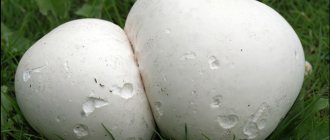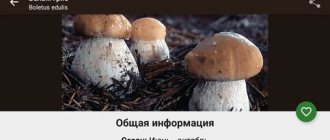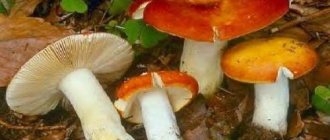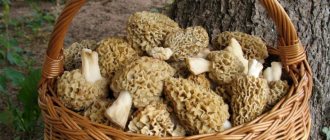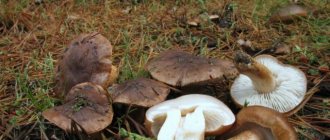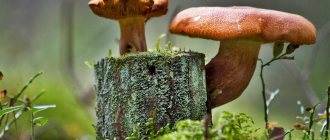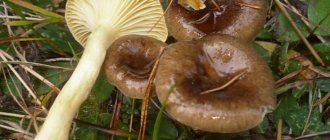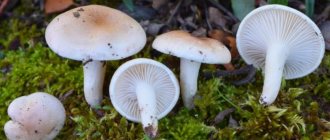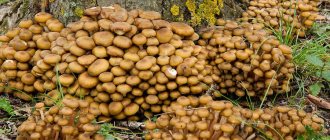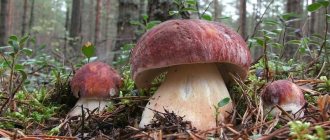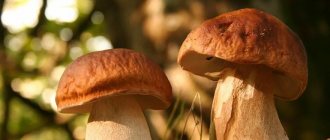The best time has come to collect the gifts of the forest - mushroom time. Every weekend I go to the autumn forest for a “silent hunt”. It is so beautiful and calm here that you can relax your soul, admiring the riot of colors of the autumn forest, gain strength and, without noticing it, collect a good harvest of edible mushrooms.
Since I am a rural resident, I love the forest and know mushrooms well, I would like to give recommendations and advice to beginning mushroom pickers: I’ll tell you about autumn mushrooms; I will give them a brief description; I will provide unique photos; I’ll tell you how to pick correctly and what mushrooms you should be wary of. Also, you will learn about the beneficial properties and contraindications for using this product in food.
Autumn mushrooms
Mushrooms are a unique product, surpassing meat in the amount of protein. Widely used in cooking and medicine, as it has healing properties. Picking mushrooms in the fall is a fun and interesting activity that brings considerable benefits.
It allows you to add a healthy and valuable product to your diet, as well as make preparations for the winter: dry, pickle, fry, cook mushroom caviar and much more.
Useful properties of mushrooms
The benefits of mushrooms have long been proven by scientists. They are a source of essential proteins that have a beneficial effect on the human body. Biologically valuable substances such as proteins, fats, carbohydrates, vitamins and microelements are well balanced, and the mushrooms themselves are low in calories.
When mushrooms are dried, their protein mass increases. Vitamins contained in mushrooms, such as A, D, E and PP, have a beneficial effect on blood vessels, the nervous system, skin, hair and nails, and can also remove bad cholesterol from the human blood.
Mushroom harvest
They contain a high content of minerals, calcium, iron, B vitamins, which are responsible for the functioning of the nervous system, brain and skin. Lecithin, contained in the pulp of mushrooms, cleans cells and blood vessels, and riboflavin promotes the growth of nails and hair.
Truffles are the most expensive mushrooms in the world, obtained with the help of pigs and dogs.
They grow underground and have a special, unusual aroma, for which they are valued by gourmets. Their price is approximately 5 - 7 dollars per gram. The cost of the most valuable black truffle is 500 thousand euros per kilogram.
How to pick mushrooms correctly
We must not forget that you need to be attentive and careful when picking mushrooms, so as not to accidentally put false and poisonous specimens into the basket. There are simple rules for collecting mushrooms that must be followed:
- Ruthlessly throw away those copies that are unfamiliar to you and raise doubts. After all, even a piece of a poisonous mushroom can cost a person his life.
- Collect only in environmentally friendly places. It is prohibited to collect mushrooms along roads and highways.
- Do not take old and overgrown mushrooms into the basket, as they accumulate substances harmful to humans.
- Do not take forest products that contain mold, as they can cause poisoning.
- Carefully examine each mushroom you find, as false ones are often disguised as edible ones.
- Collect only young, dense and clean mushrooms, with intact caps, legs and without wormholes.
- It is recommended to use wicker baskets that allow air to pass through well.
- At home, the harvested crop must be immediately cleaned, disassembled and sorted by type.
- It is advisable to prepare it on the same day, without putting it off until tomorrow.
- The best time to collect forest harvest is considered to be early morning.
- Never pull the mushroom out of the ground, but carefully cut it off with a knife at the base of the stem.
- For better preservation, mushrooms are placed in the basket with their caps down.
- After cutting, the mushroom must be immediately cleared of soil and debris.
Autumn edible boletus mushroom
The most beautiful mushrooms in the world
Fungi are members of a huge group of organisms that includes microorganisms such as yeasts and molds. Fungi are a whole kingdom, separate from plants, animals and bacteria. Fungi play an important role in the decomposition of organic matter as well as in the food chain. There are from 1.5 to 5 million species of mushrooms in the world. Below you will find the most beautiful and interesting of them.
1. Blue milky (Lactarius indigo). A fairly common species of mushroom, it grows in eastern North America, East Asia and Central America. It grows on the ground in both deciduous and coniferous forests. Color varies from dark blue in fresh mushrooms to pale blue-gray in old ones. The milk that the mushroom produces when cut or broken is also blue. The cap is 5-15 cm, the leg is 2-8 cm in height and 1-2.5 cm in thickness. The mushroom is edible and sold in rural markets in Mexico, Guatemala and China.
2. Panellus of the species Panellus stipticus. A common species, it grows in Asia, Australia, Europe and North America. It grows in groups on logs, stumps and trunks of deciduous trees, especially oaks, beeches and birches. This is one of the bioluminescent species of mushrooms, although there are no mushrooms of this species from the Pacific regions of North America.
3. Orange tremella (Tremella mesenterica). This fungus most often grows on dead trees, but also on recently fallen branches. The gelatinous orange-yellow body of the fungus (up to 7.5 cm in diameter) has a sinuous surface that becomes sticky and slippery when it rains. The fungus grows in cracks in the bark, appearing when it rains. A few days after the rain, it dries out and turns into a thin film or shriveled mass that can be reborn after the rain. This fungus is widely found in mixed forests and is distributed in temperate and tropical regions, including Africa, Asia, Australia, Europe, North and South America. The mushroom is edible, although it is considered tasteless. This fungus produces carbohydrates that are valuable for research.
4. Rhodotus (Rhodotus palmatus). This mushroom is the only representative of the genus in the Physalacriaceae family. Not very common. The mushroom is collected in eastern North America, northern Africa, Europe and Asia. In Europe, the number of mushrooms is rapidly falling, so Rhodotus was included in the Red Book. Typically grows on the stumps and logs of rotting hard trees. Mature mushrooms have a pinkish color and a characteristic “vein-like” surface.
5. Pale brown Clavaria (Clavaria zollingeri). A widespread type of mushroom. It has a tube-shaped purple or pinkish-lilac body that grows up to 10 cm tall and 7 cm wide. The tips of the fragile and thin branches are usually rounded and brownish. This is a saprobic type of fungus, it absorbs nutrients by breaking down organic matter. Usually grows on the ground.
6. Starweed (Geastrum saccatum). Grows in North America and Europe on rotting trees. Mushroom pickers consider it inedible due to its bitter taste. A fairly common species, peak collection occurs at the end of summer. It is believed that the hole on the outer layer of the mushroom's body is star-shaped due to the collection of calcium oxalate crystals just before opening. In Brazil, the mushroom is called the “star of the earth.”
7. Scaly polypore (Polyporus squamosus). A widespread species of mushroom, it grows in North America, Australia, Asia and Europe. It causes white rot on hardwood trees. An alternative name for the mushroom, Dryad's Saddle, refers to Greek mythology and the dryads who could allegedly ride on these mushrooms.
8. Aseroe rubra. The so-called sea anemone is widespread and recognizable due to its unpleasant rotten smell and starfish shape. Grows in gardens on the forest floor and in grassy areas, it resembles a red star covered in brownish slime and has a white stalk. Attracts flies.
9. Coral mushroom (Clavulinopsis corallinorosacea). The mushroom is called so because of its resemblance to sea corals. These mushrooms have bright colors, mostly orange, yellow or red. They usually grow in old forests. Some coral fungi are saprotrophic, while others are symbiotic or even parasitic.
10. Brown puffball (Lycoperdon umbrinum). This type of mushroom grows in China, Europe and North America. These mushrooms do not have an open cap with spores. Instead, the spores appear internally, in a spherical body. When mature, the spores form a gleba in the center of the body, which has a characteristic color and texture.
11. Caesar mushroom (Amanita caesarea). A very valuable edible mushroom native to southern Europe and North America. This mushroom was first described by Giovanni Antonio Scopoli in 1772. The rulers of the Roman Empire loved him very much. It has a characteristic orange cap, yellow spore-bearing plates and a stalk. This mushroom was highly valued by the ancient Romans, who called it Boletus.
12. Mycena interrupta. This mushroom grows in Australia, New Zealand, Chile and New Caledonia. In Australia it grows in Victoria, Tasmania, New South Wales and South Australia, as well as in Queensland, although only in Lamington National Park. The mushroom cap is 0.6-2 cm, and they have a bright blue color. They are spherical when they appear and become wider as they mature. The hats are sticky and feel slippery, especially when it rains.
13. Elegant Xanthoria (Xanthoria elegans). This mushroom grows on rocks, often near bird perches or rodent burrows. By nature it is a lichen. It was one of the first lichens to be used in a rock surface dating technique known as lichenometry. It grows at a rate of 0.5 mm per year during the first century, and then its growth slows down slightly.
14. Conical morel (Morchella conica). An edible mushroom that resembles a honeycomb at the top. It consists of a whole network of wavy stripes with cavities between them. Very appreciated among gourmets, especially in French cuisine. The mushroom is very popular among mushroom pickers, not only from a commercial point of view, but also because of its pleasant taste.
15. Red fly agaric (Amanita muscaria). The well-known fly agaric is a poisonous and psychotropic basidiomycete mushroom. It grows in the northern hemisphere, but has also been introduced into countries in the southern hemisphere, first as a symbiont in coniferous forests, and then as a full-fledged species. Red cap with white dots - who doesn’t know the fly agaric? This is one of the most recognizable mushrooms in the world. Although fly agaric is considered poisonous, there are no confirmed cases of fly agaric poisoning, and in some parts of Europe, Asia and North America it is eaten after blanching. Fly agaric has hallucinogenic properties, its main psychotropic component is muscimol. Some peoples of Siberia use it as an entheogen, and it has great religious significance in these cultures.
source
app 1:
Sarcoscipha bright red
(Sarcoscypha coccinea)
Synonym: grandma's ear. From the Sarcoscyphaceae family. The cap is 1-5 cm in diameter, cup- or glass-shaped, fleshy, bright red, whitish on the outside, and woolly.
The leg is 1-3 cm high, up to 0.5 cm thick, whitish. Taste and smell are weak. Found in groups in early spring (sometimes in February), after snow melts, on dry twigs, buried wood and other plant debris. Sarcoscipha bright red is not only a very beautiful, but also a tasty mushroom. Fry, boil
.
Purple rower (lat. Lepista nuda) is a mushroom from the genus Lepista of the Rowaceae family. Synonyms: “naked lepista”, “purple lepista”, “blue”, “titmouse”.
The saprophyte grows on rotting leaf litter. It grows on litter, on soil, on fallen pine needles near piles of brushwood and straw, in coniferous (pine, spruce) and mixed (oak, spruce) forests, on compost heaps, as well as in gardens. Tolerates light frosts well. Fruiting bodies appear individually or in groups, sometimes forming “witch circles”. Often grows together with smoky talker. The mushroom is widespread and common in the temperate zone of the Northern Hemisphere; brought to Australia.
Season: August - December (mass fruiting - from mid-September to the first frost at the end of October).
Coral blackberry (Hericium coralloides) or simply popularly “ deer antlers or horns ” is a mushroom of the Hericium family and genus.
The distribution area is the forests of the European part of Russia, Western and Eastern Siberia, the Far East, but what about Karelia, there are deer antlers there, the mushroom was also found north of Karelia in the Murmansk region.
Personally, I have only encountered such a mushroom with a yellowish coloring, but, as they say, there are also white ones.
In September we don’t come across it often; during a two-week trip it would be good to find 2-4 of them through joint efforts, but sometimes we didn’t find more than one. Although our friends in the Irkutsk region collect them in baskets at the end of August to September. In general, you need to know the places!
Who would have thought that the mushroom was also edible, somehow I was wandering through the forest and came across such a miracle, I didn’t pick it, I just photographed it and already in the camp they told me about its taste. I had to go back for it.
As for preparation, it is no different from other mushrooms. First, cook for about 30 minutes, and then put it in a frying pan, fry it until done and enjoy the taste, somewhat reminiscent of champignons, but meatier or something.. We also recommend making pizza with these mushrooms, it will turn out very tasty.
The mushroom is listed in the Red Book of the RSFSR, so if you resist the temptation to try it, leave the mushroom untouched.
White
Addendum 2: from my August trip to Karelia
fox
It grew on a stump; unfortunately, I don’t know what kind of mushroom it is.
this is also a stump with two different mushrooms, which has droplets of resin - I saw it for the first time
I saw this lichen many times in Karelia, but this was the first time I managed to bring it into focus
cute little bastard. also not recognized by me
Autumn edible mushrooms
This year, the forest is especially generously giving us its gifts, and there are even a scythe of mushrooms in the autumn forest: boletus, aspen, white boletus, honey mushrooms, russula, trumpets and many more different mushrooms that can be collected until frost.
Late autumn mushroom
Autumn white mushroom
Porcini mushroom is the most beloved, valuable and very tasty forest product. It has a delicate aroma and excellent taste, suitable for drying, frying and all kinds of preparations for the winter.
Porcini
It has a lot of useful properties, one of which is the content of selenium - an important element in the treatment of oncology. The pulp of the porcini mushroom is dense, clean and juicy. The young mushroom has a convex brown cap, which can reach up to 30 cm in diameter.
The leg is dense, plump and this is a distinctive feature from other species. The color of the leg can be white or brown. Even inexperienced mushroom pickers will recognize such a specimen and will definitely put it in their baskets. You need to know that the porcini mushroom is the most susceptible to a dirty environment and instantly absorbs all harmful substances.
boletus mushroom
boletus mushroom
Boletus is the most common and popular mushroom in our country. This name was given to it because it grows in birch forests on sunny edges. It is believed that the nutritional value of this mushroom is similar to that of meat.
In terms of the content of amino acids and minerals, it is only slightly inferior to the porcini mushroom. Boletus is difficult to confuse with other mushrooms. It has a cute brown cap, sitting on a thin stem, 10 to 12 cm high. Autumn boletuses are distinguished by a dense and thick stem. People call him “grandfather”.
Boletus: photo and description
Boletus mushroom
Sturdy, handsome creatures with red hats hide under the aspen trees in the fall; they are popularly called “redheads.” Typically, boletuses grow in aspen forests, which is why they got their name. The mushroom caps are barely visible in the autumn foliage.
Boletuses are always distinguished by their brightly colored cap, which grows up to 20 cm in diameter and has a velvet surface. The strong, tall stem of the mushroom thickens downwards, and on its surface there are small brown scales. When cut, the stem turns blue and then turns black, as does the flesh of the cap.
Russula red mushroom
Russula mushroom
Russulas are small mushrooms of different colors on light stalks. What types of russula are there? Cute russulas are pleasing to the eye and come in pink, yellow, red and blue. Yellow specimens are considered dangerous because they can easily be confused with the pale grebe. Therefore, collecting them is not recommended.
Russulas belong to the lamellar types of mushrooms. The plates are located on the inside of the cap and range from white to yellowish in color. The mushrooms have a pleasant taste and a cap with dense flesh on a low stem.
An adult specimen becomes fragile and crumbles easily. Usually they are collected only by russula lovers, since they are not particularly valuable for the human body.
Butter: description, photo
Butter
Butterflies got their name from their sticky and shiny cap. The mushroom is beautiful and looks as if its cap had been oiled. Butterflies come in small and medium sizes.
The yellow or light brown cap grows no more than 15 cm in diameter. The color depends on the light in the forest. The darker the forest, the brighter and more saturated the color of the oil.
Returning from the forest, the top sticky film is removed from the butterfly cap, since it tastes bitter and the mushroom is eaten without it. Small marinated boletus for the winter is a great delicacy!
Volnushka pink
Volushka mushroom
Volnushki appear in the forests in autumn. In our country they are popular and used for pickling. People call such mushrooms “pickling”. Volnushka has many varieties that differ in appearance, but taste almost the same. More often than others in the forests, the pink wave or “volzhanka” is found.
Matryoshka mushroom: photo and description
Matryoshka has a brown velvety cap that grows up to 20 cm in diameter. The stem is short and darkens when cut. The mushroom has hard and thick flesh. As a rule, it grows in whole groups and is considered edible and suitable for fried consumption. Although, it doesn’t have a special taste.
According to scientists, matryoshka has antitumor properties and is a natural antibiotic. But some scientific mycologists speak negatively about these mushrooms and do not recommend using them as food, so as not to harm health, since the mushroom is capable of absorbing and accumulating harmful substances and heavy metals in large quantities.
Matryoshka
Little-known but quite edible mushrooms
This type of mushroom is less common, is not very popular, and mushroom pickers often simply do not notice them.
Polish mushroom
It has a wide cap with a diameter of up to fifteen centimeters. The flesh of the cap is yellow, blue at the cut site, then turns brown. The leg is light brown, up to three centimeters thick.
This mushroom is consumed boiled, dried and pickled.
Garlic
It is found on the trunks of fallen trees, on stumps, and next to anthills. It can also be found in fields on last year’s compacted grass. Belongs to the family of ordinary trees. It grows in entire colonies.
The mushroom is small, the cap is no more than three centimeters, with a tubercle at the base. The color is creamy brown. The pulp is thin, lamellar, and when rubbed it releases the smell of garlic.
The leg is thin. The color is brownish-red.
The mushroom can be boiled or fried. It retains its properties well even when dried. When frozen, the taste is no different from fresh.
You can grow this mushroom in your summer cottage. Dig up the mycelium with a large amount of earthen clod and transfer it to the garden bed. Add the mixture for planting champignons and water. The mushroom takes root quite quickly and bears fruit well.
Scaly
Found in deciduous (occasionally coniferous) forests. It can grow on stumps, fallen trees, and around trunks. These mushrooms grow in bunches, like honey mushrooms.
The hats are spherical in shape with a diameter of ten to twelve centimeters. The color of the cap is pale yellow, turning into brownish-brown as it grows. A distinctive feature of the mushroom is the triangular scales, which are located like needles over the entire surface.
The leg is dense and up to ten centimeters high. There is a mushroom ring on it. The pulp is dense and becomes very coarse over time.
The mushroom is edible, but it is better to collect it before it is overgrown. In addition, you should not eat mushroom stems.
The list turned out to be long, but this is not all existing edible specimens. Study mushrooms, expand your mushroom horizons and join the “quiet hunt” lovers.
0
0
Copy link
Collecting autumn mushrooms: tips for mushroom pickers
In recent years, the topic of ticks has become more relevant than ever. They are active from early spring until autumn, so it is extremely important to protect yourself from tick bites in the autumn.
- Be sure to wear the right clothing to cover all parts of your body.
- Use tick repellents.
- After a walk in the forest, be sure to shake out all your clothes outside.
- If you are bitten by a tick, you must consult a doctor promptly.
- When preparing for the winter, use only proven methods and recipes.
- Try not to buy mushrooms from sellers on the street or even in stores that do not have official permission.
- Always adhere to strict rules for preparing and preparing mushrooms.
- If you are poisoned by mushrooms, immediately call an ambulance. Delay can cost your life.
- When going into the forest, take care of your safety: first charge your mobile phone, take a compass and clean drinking water.
Fungi that live and parasitize on tree trunks live up to eighty years and are called tinder fungi.
It is important to follow these simple recommendations to protect your life. We definitely need to learn to appreciate everything that nature gives us and treat it with care. And then the next time you come to your favorite mushroom place, you will again find a good harvest of mushrooms there.
False mushrooms
False mushrooms are dangerous to health. They are often found in the forest, and even experienced mushroom pickers can encounter this feature. Honey mushrooms, chanterelles, boletus and porcini mushrooms are false.
They are distinguished by their bitter taste. Signs of poisoning may appear within half an hour. Before the doctors arrive, you can take activated carbon tablets (in the amount of 1 tablet per 10 kg of person’s weight) and drink a lot of water.
Autumn forest: false mushrooms
Of the especially dangerous autumn mushrooms - doubles, we can mention autumn honey mushrooms. The best collection time is considered to be mid-September. Autumn honey mushrooms are beautiful, strong mushrooms with thick stems, with a pleasant smell and excellent taste. They often grow in large groups on stumps.
The counterpart of the autumn honey fungus is the brick false honey fungus, which grows in deciduous forests. The main difference between the dangerous double is that there is no characteristic ring on the leg, like a real honey mushroom.
Edible types of mushrooms in a pine forest
If the forest develops naturally, there is enough rain and sun, then diversity develops that satisfies any whim of the mushroom picker. Let's go through the most famous types of edible inhabitants of the pine forest.
Late oiler
It begins to bear fruit in May, and can produce 3-6 waves of harvest per season. It can even appear in single pines. It can be seen by the slightly raised ground near the tree.
Pine white mushroom
Such a treasure under the pine trees is a sign of a good forest microclimate. Often found along the edges of forest belts. It can be confused with its inedible counterpart - bitterling, but it is enough to know that the white one always has a white hymenophore and flesh on the cut. The false one turns red, and the spongy part is pinkish, and it also smells rotten and tastes very bitter.
The fox is real
It grows in one place for many years. It is interesting not only for its taste and bright appearance. It contains an antiparasitic substance, due to which it is not affected by pests. Usually such properties are found in poisonous mushrooms, but chanterelle belongs to the second category of edible mushrooms.
Autumn honey fungus
This delicacy is found not in the pine trees themselves, but on their stumps, which remain after felling or a storm that has knocked down a tree. It benefits both people and nature: it provides a unique taste to dishes and recycles old wood.
Greenfinch
She has fans who won't accept anything else. Greenfinches grow in groups on sandy soils, in the damp lowlands of pine forests. Like the oiler, the greenfinch can be found completely underground, slightly raised in the form of a mound.
You may be interested in:
By car to pick mushrooms: mushroom places in the Moscow region When summer ends, sadness often sets in. But, you can drive it away if you get into the car and go to...Read more...
Ryzhik
A gourmet mushroom, ideal for pickling. Grows in pine forests between trees or in sunny meadows. Belongs to the lamellar species, produces “milk” on the cut.
Variegated hedgehog
Conditionally edible mushroom. Grows on dry pine trees. Only young and unripe ones are suitable for food, since the bitterness disappears in them during heat treatment, while the old ones do not. The specific smell inspired cooks to dry the mushroom, grind it in a coffee grinder and use it as a seasoning.
This is not a complete list of edible species in the pine forest. This also includes a variety of russula, umbrella mushroom, which after frying looks like chicken meat, Polish, black podgruzok, grainy butterdish, string, morel, flywheel, truffle, and even truffle, but more often they appear in deciduous forests than in pine forests.
The most poisonous mushrooms
What you need to know about autumn mushrooms
When going into the forest, inexperienced mushroom pickers risk picking up inedible mushrooms that are dangerous to health and life. Poisoning with poisonous mushrooms has serious consequences. It is better for beginners to go with experienced mushroom pickers or thoroughly study all edible and poisonous mushrooms in order to know them by sight.
Toadstool mushroom
Such a dangerous mushroom as toadstool can easily be confused with russula. It is so poisonous that its poison cannot be destroyed even with prolonged heat treatment.
The smallest piece of toadstool can cause significant harm to the human body.
This is what autumn inedible mushrooms look like
Signs of poisoning do not appear immediately, but only after a few hours. When the first signs appear (vomiting, sharp abdominal pain, loose stools), you should immediately consult a doctor.
Fly agaric mushroom
Fly agarics are very beautiful and noticeable mushrooms from afar. The bright red cap with white speckles looks stunning against the fall foliage. The fly agaric is an inedible, but unique mushroom.
Fly agaric mushroom
Although it is a poisonous mushroom, it is pleasant to admire such a handsome man. Beautiful, isn't it?
According to scientists, it contains many useful and medicinal substances. Many people, with great care, have already learned to use its medicinal properties: they make tinctures for rubbing sore joints, treat osteochondrosis, arthritis and radiculitis. It is also believed to have anti-cancer properties.
Under favorable conditions, fungal spores can remain in a state of “sleep” for centuries, and then “wake up” and germinate.
Symptoms of poisoning appear almost immediately after consumption: hallucinations begin, vision deteriorates sharply, excessive salivation appears, vomiting, and blood pressure rises. In the absence of timely assistance, a person may die.
fly agaric
Poisonous and inedible mushrooms in a pine forest in autumn
Of course, the list does not end with edible mushrooms. All season, and especially in the fall, there are quite dangerous fruits among the pines.
Gorchak. Boletus's counterpart, inedible, can cause cirrhosis of the liver. The taste is bitter, usually with a suffocating odor. Not affected by pests. Among those unsuitable for food, pepper, ringed cap, cattail, and garlic also grow.
Gorchak
The pine tree is decorated with various fly agarics:
- panther;
- grey-pink;
- red;
- toadstool.
Since they are all known to be poisonous, they are not usually collected, but they look very attractive.
Pale toadstool is also found among the pines, very dangerous, with a 100% fatal outcome when consumed, the type and description of which must be known by heart.
Remember!
Even if it just fell into the basket, then to insure your life you should throw away the entire basket, because even a tiny particle contains a lethal dose of poison.
It is good to learn the type of sulfur-yellow honey mushroom so as not to be confused with an edible one. Its poison does not die when cooked, and when preserved it even enhances its effect. True, if you consult a doctor in time at the first signs of poisoning, a person can be saved and health restored completely.
You may be interested in:
How many days do mushrooms appear after rain and how quickly do they grow (19 photos)? There is a stereotype that after a good rain you should go mushroom hunting. But few people specifically can...Read more...
Honey fungus sulfur-yellow
For natural balance in a pine forest, all species are needed, which means that the presence of poisonous ones must be treated with understanding. The main thing is to arm yourself with knowledge and be careful.
Old overripe mushrooms
You cannot collect and eat old overripe specimens, even if they have not been touched by worms. Such mushrooms are large in size, have loose pulp and contain breakdown products of proteins and other substances.
Russula mushroom
Toxins found in old mushrooms can disrupt the respiratory and nervous systems and disrupt the heart rate.
There is even a saying: “The mushroom has outgrown - the man has found danger on his nose.”
Mushrooms growing in contaminated areas can also lead to poisoning, as they have the ability to absorb nitrates, pesticides and other harmful substances from the environment. It is prohibited to collect mushrooms near roads, near landfills and under power lines.
How to recognize boletus
As soon as foresters call the porcini mushroom: boletus, capercaillie, bugbear, and ladybird. But despite the abundance of names and minor external differences, most belevyaks are easily recognized by their characteristic cap, stem, size and color of the flesh.
hat
The porcini mushroom is distinguished by a convex and slightly overhanging cap, which becomes more flattened with age, with a diameter of about 15-30 cm.
Depending on the air temperature, its outer part changes: in the heat it cracks, in the rain it becomes covered with a small amount of mucus, and in drought it shines.The tubular layer at the bottom of the cap comes off easily and is olive-yellow in color, becoming green over time.
In the photo you can see that the color of the porcini mushroom cap is determined by the trees growing nearby.
A dark brown color with pinkish edges is characteristic of a pine forest, a coffee mushroom with a green tint is found among spruce trees, and near larches, boletus mushrooms acquire a light, beige tint or yellow ocher color.
Pulp
The pulp of the porcini mushroom is dense and light, but over time it turns noticeably yellow. The color does not change after contact with the knife.
The smell and taste of raw boletus are weak, but intensify during cooking.
Leg
The hallmark of the white hare is the “barrel” or “pin” leg, which on average has a height of about 10 cm and a thickness of up to 8 cm.
However, the older the mushroom, the more the base stretches and thickens. Usually the legs of boletus mushrooms are brownish with whitish and reddish tints.
Contraindications to the use of mushrooms in food
- It is not advisable for elderly people to eat mushrooms. This is a product that is difficult for the body to digest and absorb;
- It is contraindicated for pregnant and lactating women;
- It is forbidden for people with chronic gastrointestinal diseases to eat;
- Not recommended for children under 12 years of age.
Even healthy people should not eat mushrooms in large quantities, since they contain a high protein content, which is difficult and takes a long time to digest and consumes a lot of the body’s energy.
From the video you will learn how to properly remove a mushroom from the soil
